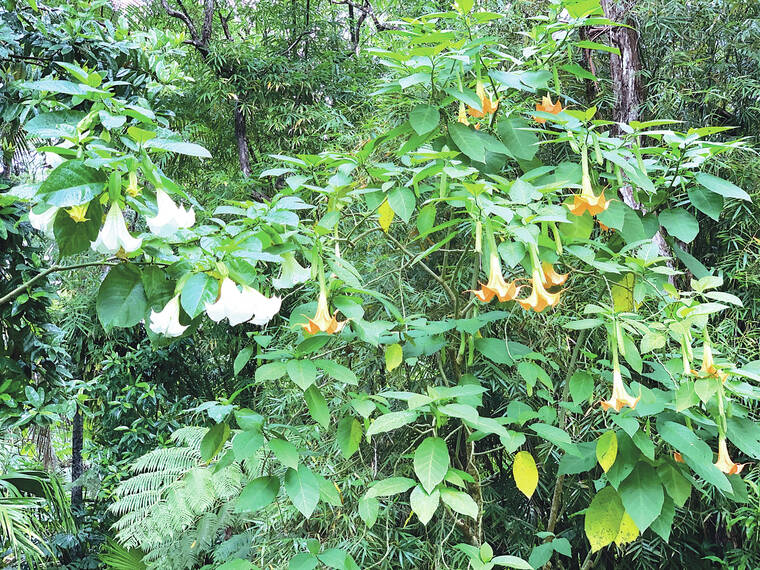Our islands have few dangers except for rare volcanic eruptions, earthquakes and hurricanes. Excessive exposure to the sun can be dangerous, and carelessness can cause accidents while hiking in the mountains or swimming in the ocean. Although there are few poisonous native plants, some common exotic landscape plants are toxic such as oleander, crotons and angel trumpets. Some people can experience skin reactions like exposure to poison ivy from cashew and mango trees.
When it comes to animals, most folks don’t know that we have a native very poisonous snake. The yellow-bellied sea snake is found through out the tropical Pacific including Hawaii. Then there are the giant cane toads (Bufo marinus) that some have confused with bullfrogs. The toad’s skin is toxic so eating them is bad news! We also have a cute green and black dart-poison frog on Oahu. It is not a good idea to play with them.
There is another kind of peril that isn’t quite so obvious and it is the destruction to our environment by accidentally introducing diseases and pests. Many of the plant diseases we have today did not exist before humans arrived. Once here, they are not easy to control.
The best disease prevention measure you can take with ornamental plants, fruits and vegetables is to start with healthy or disease-resistant plants. A common fungus referred to as plumeria rust shows up on many garden plumeria especially in wet or rainy weather. Symptoms show up as a rusty appearance on the underside of leaves causing premature yellowing and dying of leaves.
According to University of Hawaii plant pathologists, once a plant becomes badly diseased, it is difficult to nurse it back to health. For this reason, every effort should be made to prevent introduction of disease organisms on plant material or in soil. Many common plant diseases are caused by fungus organisms. Others are caused by virus and bacteria. Identifying the cause is vital to knowing the proper cure.
Plants in poor growth are usually more susceptible to these diseases. Good cultural and sanitation practices will help prevent trouble such as removing diseased parts like leaves or branches as soon as they appear affected. Treat pruning wounds with a specially prepared material to stop entrance of wood-decaying organisms and wood-feeding insects.
For treatment of fungus-diseased plants, fungicide applications should begin when disease development first appears and should continue as recommended by the manufacturer.
Algae commonly grows on the surface of soil that is moist for periods of time. This is very common during the rainy season. These minute green plants often develop in such profusion that they form a rather thick, greenish to blackish mat. Growth of such magnitude in a turf planting is detrimental to the grass because algae actively competes with the grass for both space and nutrients. In addition, if the algae mat dries, it forms a crust that retards or prevents the movement of water into the soil. If this occurs, the grass is subjected to a moisture stress directly due to the presence of the algae.
The same conditions that favor the growth of algae also favor the growth of fungi that cause turf grass diseases. In fact, a close association has been noted between frequent disease outbreaks and the presence of algae. Therefore it is desirable to control both these problems with one practice. Reducing the moisture level would be the ideal method; however, in many situations, this is not possible. Other control measures must be used. The use of fungicides that are effective against both turf diseases and algae is an efficient method of control.
Your local garden supply or nursery can assist you on the correct material to use. You may also call the Master Gardener hotline at the University of Hawaii College of Tropical Agriculture. In Hilo, the main number is (808) 981-5199. In Kona, the main number is (808) 322-4893. You may then be directed to extension staff or master gardeners to assist you.
Bacteria, fungus and algae are not always doing harm. Our edible limu is an algae, yogurt is the result of a certain type of bacteria, and those delicious mushrooms on your steak are a fungus. These beneficial organisms are important to a healthy soil, and to healthy nutrition. Many that are yet to be discovered may be key in developing new drugs to fight disease in plants, animals and humans.
However, prevention of disease organisms is vital and includes keeping them out of Hawaii. Some folks are unhappy when they find they can’t bring certain plants or seeds to Hawaii or, if they can, they have to go through all kinds of red tape, fumigation or extended quarantines to introduce new plants. They might smuggle a few plants thinking it won’t make any difference.
This attitude couldn’t be further from the truth or more dangerous. If it weren’t for people bringing in disease- and insect-infested plant materials, our island would not be plagued with such creatures as fruit flies, burrowing nematodes, and many other pests that damage food crops as well as ornamentals. Now there are serious fines and even imprisonment for plant or animal smuggling.
There are ways to bring in new plants to Hawaii legally. The Hawaii State Department of Agriculture and U.S.D.A. Plant Quarantine Office can give you the details.
By following the law, hundreds of new plant introductions are being made each year. These can enrich our lives without bringing with them unwanted insects and diseases that could bring disaster to our economy.
——
Norman Bezona is professor emeritus, University of Hawaii College of Tropical Agriculture and Human Resources.






